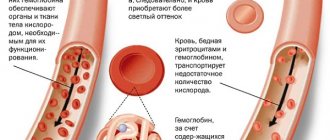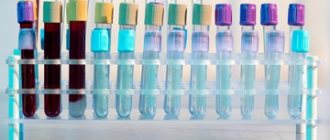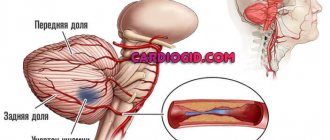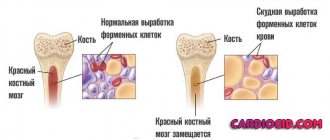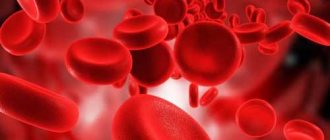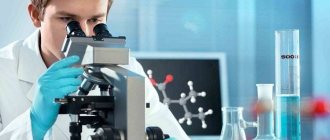You are here: Blood test -
Hemoglobin -
High hemoglobin
- Etiology
- Symptoms
- Diagnostics
- Treatment
- Possible complications
- Prevention and prognosis
High hemoglobin is a peculiar sign that is detected during laboratory blood tests. Elevated values are no less dangerous than low concentrations of the main component of red blood cells. The blood of both adults and children undergoes similar changes.
The reasons for deviations from the norm can be very diverse, ranging from many years of addiction to bad habits and changes in atmospheric air to the occurrence of dangerous illnesses, for example, oncology.
The symptoms of such a disorder are very often veiled under the external manifestations of the underlying illness. However, the main signs are: decreased appetite, weakness, headaches and dizziness, sleep disorders and itchy skin.
Increased hemoglobin can be detected using a general clinical blood test, both venous and capillary. However, to identify the underlying cause, a comprehensive examination of the body is necessary.
Correction of the concentration of iron-containing protein is carried out using conservative methods, including: eating certain foods and taking medications.
Etiology
A situation during which an increase in hemoglobin in the blood occurs is said when such values deviate from the permissible norm, which for a healthy man is 140-180 g/l, and for a woman – 120-160 g/l. In children, the norm varies according to age category. A level that is 20 or more units higher than the specified values is considered elevated.
High hemoglobin causes are divided into two large categories - pathological and those that are not associated with the course of any disease, that is, physiological.
The first group includes the following diseases:
- oncological process of any localization - there will be increased hemoglobin;
- wide range of allergic reactions;
- bronchial asthma;
- disruption of the functioning of the bone marrow due to its damage;
- extensive burns;
- the course of diabetes mellitus;
- intestinal obstruction;
- pathologies of the heart and kidneys;
- Gaisbeck syndrome;
- methemoglobinemia;
- internal hemorrhages;
- hypervitaminosis, in particular, an excess of vitamins B12 and B9 in the body;
- pernicious and hemolytic anemia;
- poisoning by chemicals or toxins, poor-quality food or medicines;
- pulmonary fibrosis;
- congenital heart diseases;
- autoimmune diseases;
- chronic hypoxia;
- any liver damage;
- dysbiosis.
Less harmless causes of increased hemoglobin are presented:
- insufficient fluid intake into the body;
- long-term abuse of bad habits, especially smoking cigarettes;
- professional sports;
- specific working conditions - the main risk group consists of people forced to work at heights or, conversely, deep underground;
- excessive air pollution;
- living in mountainous areas;
- early introduction of complementary foods to children;
- prolonged exposure to stressful situations;
- blood transfusion.
In addition to the above sources, genetic predisposition may be a predisposing factor.
It is also worth noting that a false increase in hemoglobin levels is possible - this is influenced by the time of day when the general clinical blood test was performed. For a large number of people, the main component of red blood cells is higher in the morning than in the afternoon. At the same time, hematologists note that falsely elevated hemoglobin has causes that include liver damage or drug overdose.
Hemoglobin norm by age
Why is high hemoglobin dangerous?
Oversaturation of the blood with red blood cells leads to a deterioration in the functioning of all systems. The blood becomes too thick, thereby negatively affecting the functioning of the brain of men and women, and also leads to a slowdown in blood circulation and disruption of blood supply to body tissues.
In addition, this condition entails an increase in the size of organs (kidneys, liver, spleen), which provokes more serious consequences.
Constantly exceeding the hemoglobin level and the presence of the listed symptoms can often lead to death.
But, don't worry, be sure to go to the doctor, drink more water, walk more in the fresh air, eat right, take vitamin C, and everything will be fine.
It is important to regulate hemoglobin levels, undergo prescribed treatment and lead a healthy lifestyle so that you do not have to deal with more serious complications.
Symptoms
Elevated hemoglobin has a number of characteristic clinical manifestations, however, in the vast majority of situations they go unnoticed during the course of the underlying disease.
If the average concentration of hemoglobin in a red blood cell is increased, then patients often experience the following conditions:
- lethargy and increased fatigue;
- decreased appetite;
- increased blood tone;
- severe skin itching, especially after a bath or shower;
- headaches of varying severity;
- dizziness;
- aches or pain in muscles and joints;
- bruises and bleeding even with the slightest trauma;
- drowsiness or, conversely, problems falling asleep;
- excessive pallor of the skin;
- disturbance of mental activity;
- drop in visual acuity;
- stomach ache;
- disruption of the process of urine emission - it is either accelerated or difficult.
Such symptoms occur regardless of the cause of high hemoglobin in an adult or child.
Diagnostics
Elevated hemoglobin can only be detected after a clinician reviews laboratory blood test data. Biological material for this procedure is removed either from a finger or from a vein. No specific patient preparation is required for such an analysis.
To identify the factor that influenced the increase in hemoglobin, the clinician needs to:
- study the medical history to search for sources with a pathological basis;
- collect and analyze a life history to establish the influence of physiological factors;
- perform a thorough physical examination of the patient, assess his appearance and condition of the skin;
- measure blood pressure, heart rate and temperature;
- interview the patient in detail to obtain complete information regarding the symptomatic picture: in some situations this may indicate an underlying disease.
Additional laboratory tests and instrumental examinations are prescribed individually for each patient, and the specialist is based on the possible causes of increased hemoglobin, as well as on the patient’s complaints and general well-being.
Treatment
When hemoglobin is elevated, the pathological root cause should first be eliminated, which can be done either conservatively or surgically, for example, when malignant neoplasms are detected.
In order for the concentration of the most important blood element to begin to decrease, patients need to follow a certain diet. First of all, you should completely avoid foods containing iron.
Thus, prohibited ingredients are:
- sour fruits and berries;
- offal and seafood;
- red meat;
- cereals and sweets;
- butter and smoked meats;
- sweet carbonated and alcoholic drinks;
- greens and legumes;
- chicken eggs and nuts;
- citrus fruits and dried fruits.
Prohibited foods for high hemoglobin
At the same time, to reduce hemoglobin in the blood, you are allowed to eat:
- dietary varieties of meat and fish;
- fresh vegetable salads;
- pasta;
- almost all types of cheeses;
- wheat bread;
- fermented milk products;
- milk chocolate.
In addition, the following medications can help reduce this substance:
- "Aspirin";
- "Courantil";
- "Trental";
- "Cardiomagnyl".
Only the attending physician can decide which medication to take and for how long. This is due to the fact that a person may not know how the medicine will affect the content of the main component of red blood cells. For example, not everyone knows that hematogen increases hemoglobin.
It should be borne in mind that after the approval of the clinician, the use of folk remedies is not prohibited.
Possible complications
High hemoglobin is dangerous because it can lead to life-threatening consequences.
Thus, refusal of qualified help can lead to the development of the following pathologies:
- an increase in blood viscosity, against the background of which blood clots form, and this, in turn, disrupts the functioning of internal organs;
- heart attack and stroke;
- cognitive impairment;
- developmental delay in children;
- confusion;
- a change in the shape of red blood cells - they become crescent-shaped - this condition is called sickle anemia;
- internal and nasal hemorrhages;
- pulmonary thromboembolism.
Drug therapy
This method consists of therapy with drugs that prevent platelet aggregation, which in turn leads to a reduction in the risk of blood clots and vasodilation.
All medications should be taken only after consulting a doctor; be sure to consult a therapist or family doctor before taking any medications without permission.
Firstly, in order for a doctor to prescribe anything, you need to take tests, blood from a vein and blood from a finger. Go to an appointment with a doctor and discuss all your questions with him.
1. Chimes. Able to suppress the activity of platelet enzymes. Its action is comparable to that of Aspirin. One of the advantages is that it can be taken by people who are intolerant to aspirin, and is also suitable for pregnant women. The drug is not recommended for high acidity and low blood pressure.
2. Trental. It has a beneficial effect on the composition and viscosity of the blood.
3. Aspirin. Used as a prophylactic against blood clots.
4. Clopidogrel. With its help you can achieve good results in treatment.
5. Tiklid (Ticlopidine). The drug is highly effective along with its analogues, including aspirin. It is important to strictly follow the rules of use and adhere to the dosage, otherwise there is a risk of developing severe conditions, such as, for example, hemorrhagic syndrome.
Prevention and prognosis
To avoid a situation in which there is increased hemoglobin in the blood, people should follow a few simple rules.
Prevention includes the following recommendations:
- complete cessation of bad habits;
- proper and balanced nutrition;
- avoiding the influence of stress;
- taking medications strictly as prescribed by the clinician;
- use of personal protective equipment when working with chemicals and toxins;
- drinking enough liquid;
- Regularly undergoing a complete preventive examination at a medical institution.
Elevated hemoglobin in itself rarely poses a threat to patients: this is only possible in the absence of treatment. In addition to the above consequences, there is a high probability of complications of the underlying disease.
Preventive measures for elevated hemoglobin in women
Prevention of increased hemoglobin in women consists of maintaining a healthy lifestyle, quitting smoking and alcohol. Normal nutrition, fresh air, a calm family atmosphere are the key to the health of any woman. It is important to remember that much depends on the personal reaction to all environmental stimuli. We must learn to live correctly. And it's never too late to do this!
Stepanenko Vladimir, surgeon
92, total, today
( 65 votes, average: 4.31 out of 5)
Low leukocytes in the blood: causes of deviations
Urea in the blood: norms, reasons for increase, ways to reduce concentration


